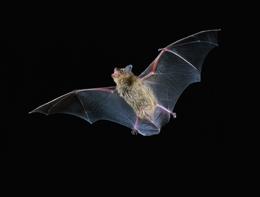摘要:发表于6月20日PNAS上的一篇文章称:蝙蝠能够利用其微小的毛发感知掠过其翅膀的空气的速度与方向,在遇到危险时,这对他们有警示的作用。
蝙蝠是唯一能够进行动力飞行的哺乳动物,它们的翅膀是覆盖着微小毛发的膜。科学家们一度认为在黑暗中飞行时,蝙蝠使用这些毛发来感知周围的环境,不过,这已经是70年前的看法了,在此后,人们发现蝙蝠是用回声定位来导航的。Susanne Sterbing-D'Angelo是一个来自马里兰大学的神经科学家,她和她的同事研究了这些翼膜上的毛发,发现它们在蝙蝠的飞行控制中起到至关重要的作用。
为了发现蝙蝠从从他们的翼毛中到底搜集到了什么样的信息,研究人员在他们的大脑中植入了电极,将他们的头和翅膀固定,以隔离振动,然后,他们将一定量的空气喷在翅膀上,并对大脑活动进行了监测。
气流会激活初级感觉皮层上的神经元,初级感觉皮层是大脑中的一个区域,可以感受到触觉。气流的强度并不大,不能激活蝙蝠翼膜上的触觉受体,于是科学家们认为在毛发的运动过程中,其他的受体,如Merkel细胞被激发。当研究人员用脱毛膏去除翼膜毛发时,神经元就不再对气流做出反应了。
当气流击中蝙蝠翼膜的尾部时,神经元的活动最强烈。该研究小组认为,来自翼膜毛发的信息可能会为蝙蝠提供信号:现在你需要稳定。
生物探索推荐英文原文:
Wing hairs help to keep bats in the air
Bats use tiny hairs to sense the speed and direction of air flowing over their wings. This may alert them to the danger of stalling and enable them to perform impressive aerobatic tricks, according to a report published today in the Proceedings of the National Academy of Sciences.

It takes more than echolocation to do aerobatics in the dark.
Bats are the only mammals capable of powered flight; their wings are made of a membrane covered with microscopic hairs. Scientists once thought that bats use these hairs to sense their surroundings when flying in the dark, but studies on them were put aside 70 years ago, after the discovery that bats navigate by echolocation. Susanne Sterbing-D'Angelo, a neuroscientist from the University of Maryland in College Park, and her colleagues took up the study of the hairs, and found that they are crucial for bat flight control.
To discover what information bats glean from their wing hairs, the researchers implanted electrodes into the animals' brains and fixed their heads and wings to a vibration-isolation table. Then they directed puffs of air at the hairs and monitored the resulting brain activity.
The air activated neurons in the primary somatosensory cortex — part of the brain that is triggered by the sense of touch. The air puffs were not strong enough to activate touch receptors in the wing membrane, so the scientists think that other receptors, called Merkel cells, are triggered by the movement of the hairs. When the researchers removed the wing hairs using depilatory cream, the neurons no longer responded to the air puffs.
The neurons fired most strongly when the air puffs hit the rear part of the wing. Airflow from behind can be a sign of turbulent conditions, so the team suggests that information from the hairs might signal to the bat that it needs to stabilize.
Flight control
The hairs are also important during normal bat flight, the researchers showed. They built artificial forests from nets and tree trunks and trained the animals to seek a banana or mealworm as a reward. "It takes months to train a bat to fly through an obstacle course," says Sterbing-D'Angelo. When the animals were used to the task, the researchers filmed them flying through the maze. They then removed the bats' wing hairs, and filmed them again. Without the hairs, the bats sped up, and their turns were wider and more cautious.
The authors suspect that the hairless bats change their flight patterns because they think they are at risk of stalling. In aerodynamics, stalling occurs when an aircraft is flying too slowly, which causes the lift forces to drop. In the bats, hair receptors sensitive to reverse airflow should pick up swirling vortices at higher speeds. Lack of signal from these receptors might make the bats think they were flying dangerously slowly, prompting them to speed up.
So it seems that evolution of the hairs may be a key feature of bats' impressive ability for aerial acrobatics, including tight turns, hovering and perching upside down. "Hairs with Merkel receptors might have evolved uniquely to bats," says Sterbing-D'Angelo. Her team tested fast-flying big brown bats (Eptesicus fuscus) as well as slower, hovering short-tailed fruit bats (Carollia perspicillata). Both species showed the same types of flight change when their wing hairs were removed.
Ideas are already springing up for how humans might copy the bats' tactics to help prevent plane crashes, among other things. "Stall is a major problem for aircraft," says Geoffrey Spedding, a zoologist studying aerodynamics at the University of Southern California in Los Angeles. He says that Pitot tubes, the devices currently used for aircraft stall detection, don't work particularly well, so any improvement that could be garnered from the bats would be welcome. "But features of animal flapping wings can't always be applied to fixed-winged aircraft," he cautions.
Belinda Batten, a mechanical engineer at Oregon State University in Corvallis, hopes to use the findings to make autonomous flying objects, or drones, more manoeuvrable. Drones are used by the military, but also have civilian applications. "We can fly them into buildings to search for people trapped after earthquakes, or over forest canopies to count bird populations," says Batten.
She envisages making artificial versions of bat wing hairs using flexible polymers with ceramic bases that respond to strain, mimicking the Merkel receptors. Planes with hairy wings? Maybe not such a batty idea.







